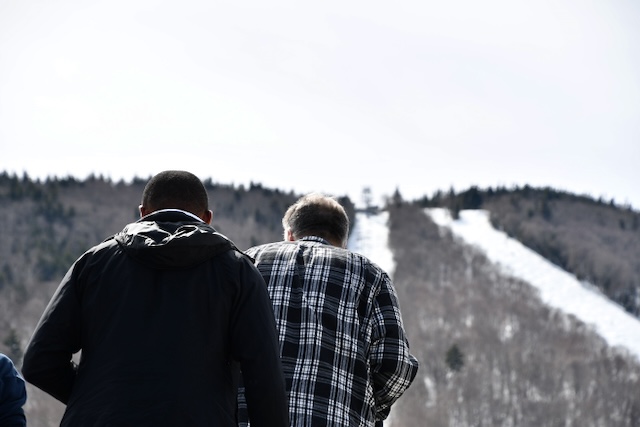In early April 2024, the Knight Science Journalism Program (KSJ) gathered staff, fellows, and their families for a trip to Vermont to see the solar eclipse. Lucky to have clear skies, the group of 30+ watched the eclipse from Sugar Bush Ski Resort in the Mad River Valley. Joined by hundreds of other visitors and armed with eclipse glasses from an American Astronomical Society-approved vendor, the stars aligned (well, actually just the one star – the sun, and the moon aligned) for everyone to witness this astronomical phenomenon.
Hailing from around the world – Boston, Washington D.C., New Jersey, Canada, England, Germany, Nigeria, Australia, and Indonesia – most of the fellows would have been far from the path of totality if it weren’t for their fellowship at KSJ.
KSJ Director Deborah Blum said of the trip: “As the world’s leading science journalism fellowship program, KSJ tries to take its fellows on at least one special science adventure every year. Once we realized that for this year’s eclipse, the path of totality would move through New England, we knew this was the perfect choice, a chance to see the sun, our most important star, in a truly spectacular way.”

In the early afternoon, the sun was high in the sky over Sugar Bush Ski Resort, where KSJ fellows and staff gathered to view the eclipse.

Eclipse viewers were keen to document the event, and KSJ fellows were no exception. Madeline Ostrander (right) takes a photo of Lisa Grossman (left). Grossman, an astronomy reporter, had coordinating eclipse outfits with her husband and two children.

KSJ Fellows Chikezie Omeje and Peter Whoriskey climb stairs at Sugar Bush, scouting for a good spot to view the eclipse. The sky was clear and the sun was bright, promising an excellent view of the upcoming astronomical event.

Hundreds of people visited Sugar Bush on April 8 to view the eclipse.

Partial eclipse as viewed from Sugar Bush Resort in Washington County, VT. Eclipse glasses darken the bright sky, allowing only some of the sun’s light through. This photo, taken through a solar filter, shows what eclipse viewers would have seen through eclipse glasses.

KSJ Associate Director Ashley Smart holds eclipse glasses in front of his phone, taking a photo of the partial eclipse. During the partial phases, the eclipse is difficult to capture with a camera. The sunlight overwhelms the photo and the “bite” from the moon is not visible. Viewers used creative methods to circumvent this overexposure and document their experience.

Sharon Begley Fellow Deborah Balthazar uses a solar filter attached to her smartphone to take a picture of the ongoing partial eclipse. Balthazar magnifies the image with an app designed to capture eclipses on phone cameras.

KSJ fellows Justin O’Neill and Lisa Grossman view the ongoing partial eclipse through a colander. During an eclipse, when the sunlight passes through the holes in the colander, the progressing “bite” out of the sun (the area covered by the moon) is visible in the circles of light on the ground.

KSJ Fellow Justin O’Neill takes a photo of the partial eclipse with a solar filter over his camera.

KSJ Fellow Kai Kupferschmidt uses eclipse glasses over his phone camera to try to take a picture of the ongoing partial eclipse.

A tiny sliver of sunlight remains before totality. Image through a solar filter.

Just before totality. Sharon Begley Fellow Deborah Balthazar, who viewed the eclipse from the crowd at Sugar Bush, recounted, “The thing that really surprised me was the drop in temperature, and how dark it got so quickly. We knew what was going to happen, but we couldn’t help but erupt in cheer.”

Fellows Kai Kupferschmidt and Inayat Singh take a selfie during totality. As a result of the blocked sunlight, the clouds behind them are streaked with pastels as if it were sunset.

Total solar eclipse. For viewers in Vermont, the moon is directly in front of the sun. When the moon blocks out the bright light from the sun’s surface during a total solar eclipse, the sun’s corona is visible. The red streaks in the image are prominences visible during totality. “It was fun watching the rest of the fellows get excited about space. It’s often just me,” said Lisa Grossman, KSJ Fellow and astronomy reporter, “I wasn’t expecting to see a prominence. That was really cool.”

Bonus Balloonar Eclipse! A moon balloon passes in front of a sun balloon, the decorations mimicking the dynamics of the solar eclipse.
Photos by Anna Cass, Communications Coordinator for the Knight Science Journalism Program




Leave a Reply